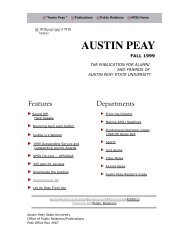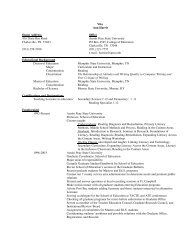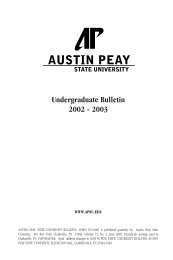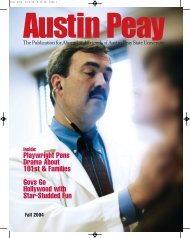Leaving on a High Note - Austin Peay State University
Leaving on a High Note - Austin Peay State University
Leaving on a High Note - Austin Peay State University
Create successful ePaper yourself
Turn your PDF publications into a flip-book with our unique Google optimized e-Paper software.
“Tim led a split life, almost three lives. He had the baseball<br />
group, the physics group and the computer science group.”<br />
—Dr. Jaime Taylor (’90)<br />
Professor of physics and chair of the<br />
APSU Department of Physics and Astr<strong>on</strong>omy<br />
When Fox started working at Emory, he<br />
c<strong>on</strong>tinued to push himself to achieve just as<br />
he did at APSU. During 1994-2000, he developed<br />
a treatment-planning software system<br />
that enabled him to aim a radiati<strong>on</strong> beam precisely<br />
where he wanted for better cancer<br />
treatment. His unique background in both<br />
physics and computer technology made it<br />
possible to create a treatment-planning system<br />
that enabled radiologists to treat a brain tumor<br />
via a precise radiati<strong>on</strong> treatment method<br />
called radiosurgery or bloodless brain surgery.<br />
After 2000, Fox and his colleagues worked<br />
with leading medical industry companies as<br />
early adopters of technology for intensity<br />
modulated radiati<strong>on</strong> therapy (IMRT). Through<br />
various kinds of medical imaging studies, Fox<br />
and his team can generate anatomical maps of<br />
a tumor and surrounding tissue. After creating<br />
the map, they employ IMRT, which wields an<br />
external radiati<strong>on</strong> beam like a knife.<br />
“We break the beam into several pencil<br />
beams, and computer optimizati<strong>on</strong> algorithms<br />
modify the intensity of each pencil,” Fox<br />
says. “This helps c<strong>on</strong>form the dose and match<br />
it to the shape of the tumor—with a different<br />
intensity for each beam. It’s a precise radiati<strong>on</strong><br />
dosage, which allows us to deliver pers<strong>on</strong>alized<br />
radiati<strong>on</strong> therapy for our patients.”<br />
In 2004, Fox and colleagues made Emory<br />
the first site in North America to implement<br />
the On-Board Imager (Varian Medical<br />
Systems) for delivering real-time image-guided<br />
radiati<strong>on</strong> therapy (IGRT). Using the precisi<strong>on</strong><br />
of IMRT, the real-time imaging system<br />
allowed his clinicians to focus the most<br />
potent radiati<strong>on</strong> treatment directly <strong>on</strong> the<br />
tumor while minimizing interacti<strong>on</strong> with critical<br />
organs and tissues. With IMRT and IGRT,<br />
they can deliver radiati<strong>on</strong> with the precisi<strong>on</strong><br />
of image-guided missiles used for their accuracy<br />
in striking enemy targets.<br />
After the Department of Radiati<strong>on</strong><br />
Oncology’s groundbreaking advance in pers<strong>on</strong>alized<br />
cancer treatment, Fox was interviewed<br />
several times <strong>on</strong> the nightly news <strong>on</strong><br />
Atlanta’s NBC and ABC affiliates.<br />
Was that the summit of Fox’s career?<br />
Hardly. Given his reputati<strong>on</strong> for never being<br />
satisfied, for always pushing the envelope in<br />
research, what’s he working <strong>on</strong> now?<br />
“Adaptive radiati<strong>on</strong> therapy using molecular<br />
imaging,” he says with a shy smile. “It’s<br />
the new wave, and it’s very exciting. We want<br />
to see and treat the tumor better.”<br />
As a leader in medical physics research,<br />
Fox has published many professi<strong>on</strong>al articles,<br />
abstracts and book chapters. He is a manuscript<br />
reviewer for the Internati<strong>on</strong>al Journal of<br />
Radiati<strong>on</strong> Oncology Biology Physics as well<br />
as Medical Physics and Physics in Medicine<br />
and Biology, and he’s a former editor of the<br />
Vascular Radiotherapy M<strong>on</strong>itor.<br />
Fox has been an oral examiner for the<br />
American Board of Radiology. In 2005 and<br />
2006, he was invited to participate as an<br />
expert reviewer and panelist for the Nati<strong>on</strong>al<br />
Institutes of Health’s Nati<strong>on</strong>al Library of<br />
Medicine Special Emphasis Panel. He’s<br />
authored grants that received funding for scientific<br />
research at Emory and Georgia Tech.<br />
Because Fox married physics and informati<strong>on</strong><br />
technology successfully, he was granted<br />
two U.S. patents for treatment planning protocols<br />
in intravascular brachytherapy, a technique<br />
that uses radiati<strong>on</strong> therapy to keep<br />
blocked heart arteries open.<br />
In recogniti<strong>on</strong> of his outstanding work, Fox<br />
also has received numerous h<strong>on</strong>ors, including<br />
the 2005 Coulter Translati<strong>on</strong>al Research<br />
Award for using magnetic res<strong>on</strong>ance spectroscopy<br />
to improve the delineati<strong>on</strong> of tumor<br />
volumes for treatment planning.<br />
Fox’s award-winning research, intelligence<br />
and intrinsic “likable factor” have made him a<br />
favorite am<strong>on</strong>g medical physicists and <strong>on</strong>cologists<br />
worldwide.<br />
As a result, he’s become an evangelist,<br />
Spring 2007<br />
A<br />
A female lung cancer survivor developed metastatic<br />
disease in the brain, seen easily in A. Using the<br />
world’s first Trilogy Radiosurgery system installed<br />
at Emory in 2004, the lesi<strong>on</strong> was treated with a<br />
single high dose of radiati<strong>on</strong>. After six m<strong>on</strong>ths, the<br />
brain lesi<strong>on</strong> is not visible <strong>on</strong> the follow-up MR<br />
imaging study, in B, indicating a complete resp<strong>on</strong>se<br />
to the radiosurgery treatment.<br />
B<br />
19<br />
Tim Fox/Emory <strong>University</strong>

















